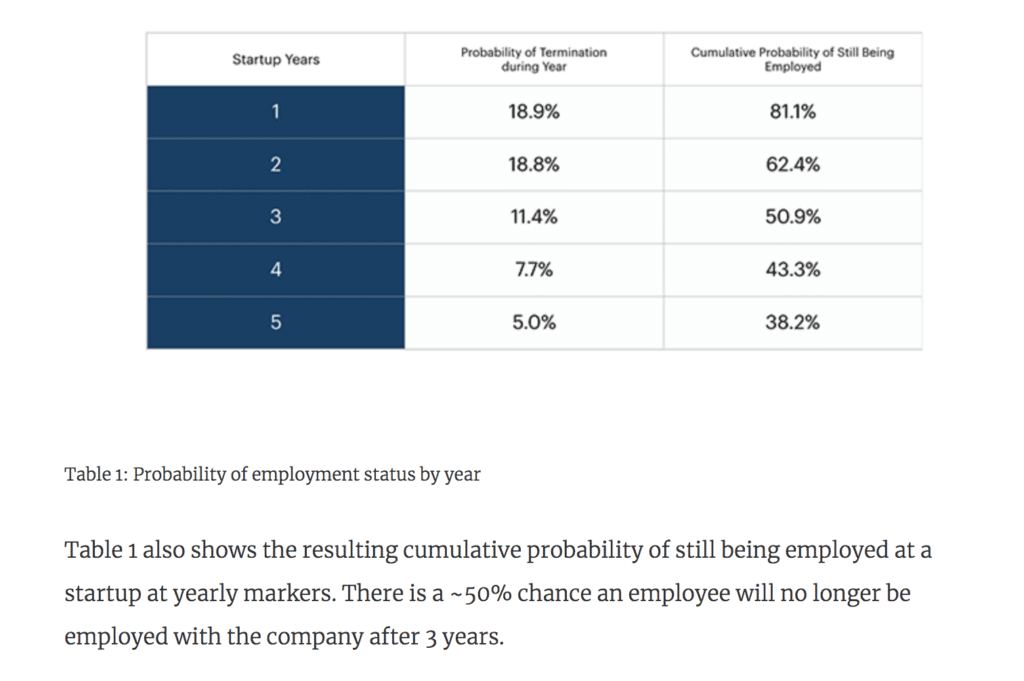A little while back I was walking on the streets of San Francisco and bumped into a terrific public company CEO. A beloved CEO of a beloved SaaS company several years post-IPO. We caught up briefly, and I asked if there was any way I could help. He said, “I’m looking for a great VP of Marketing.”
Oh goodness, I thought. It really never ends or gets easier. And it’s true … it probably doesn’t. Hopefully, you’ll have one or two great VPs that do stay forever, and go the distance. But if you look at Carta’s report analyzing stock option plans, the median tech employee tenure is less than 2 years and there’s an ~50% chance any given employee will stay for 3 years (yes, those two metrics are confusing to see side-by-side):
Things just happen, even in the best cultures and start-ups. People move away. People end up not scaling or not wanting to scale. People get tired. People that have done it before, end up not wanting to do it again. You can reduce churn on the team, but you can’t eliminate it. So as hard as it is just to build out your first management team, if you want to do it right, you also have to start planning for if you lose any of them.
So maybe the #1 thing you can do after you’ve finally built out your first management team is to build out the layer just below. Start-ups < 50-70 employees are usually fragile. Lose your VP of Product? No one can manage the roadmap. Lose your VP of Sales? Who’s going to manage all those SDRs and AEs … oy. Lose your VP of Marketing? Qualified leads slow way down. And things are a bit more fragile in SaaS and B2B. Why? Because you need more VPs earlier. You need a VP of Sales, Marketing, Product, Engineering, and Customer Success by this stage just to scale. Lose any of them, and best case, things will slow down. And worst of all — you’ll have to jump in and be the interim VP of that area. That’s a big step backwards.
Ok, so what should you do? Just a few simple suggestions / hacks that tend to work well:
- Budget, and encourage, every VP to hire a great Director under them. Now. Find the budget — even if you don’t have it — and let them hire their right-hand woman/man today. Encourage them to hire someone even better than they are, or at least were, adjusted for time. Let them hire whomever they want, more or less. This will make it easier. And just ask them — “If something, perish the thought, should happen to you … could Laura step in?” If so, just make the hire. The best VPs will appreciate it. They get budget to hire someone great that can help them carry the load.
- Be honest about if every VP can scale at least 6 months from today — or not. If you have to replace a VP, start early. Be honest with yourself. Can every VP on your team at least scale for the next 6 months? If not, don’t put it off. Bring in some sort of redundancy now.
- Do employee NPS surveys. And be prepared to not love the number and some of the feedback. Employee NPS numbers, according to the companies that do them, are generally lower than customer NPS numbers. At least measure it, and try to drive it up. If you don’t measure something, it’s hard to improve it.
- Pay more for more seniority at the Director level. A simple hack, but pay up. Don’t try to save money on the next level of management down. Many founders balk at paying up for seasoned Director-level hires when they’re only just now coping with one layer of management in their first VPs. 🙂 Underhiring may have its place, but not in management. Err on the side of hiring Directors that have managed a few folks before. That may cost you 20% more than a seemingly similar hire. Just pay it. It’s a very small price to pay for redundancy.
We all want a zero voluntary attrition team. I do. More on that here.
But SaaS is hard. If you don’t have someone that can step in for each VP, you’ll never really be able to step on the gas.
(note: an updated SaaStr Classic post)


